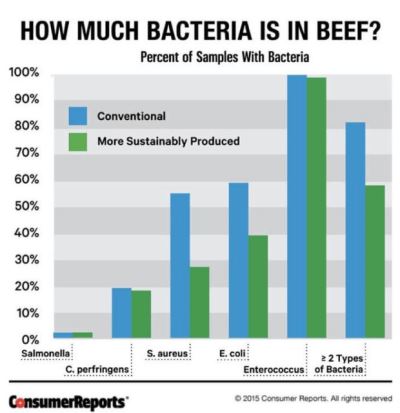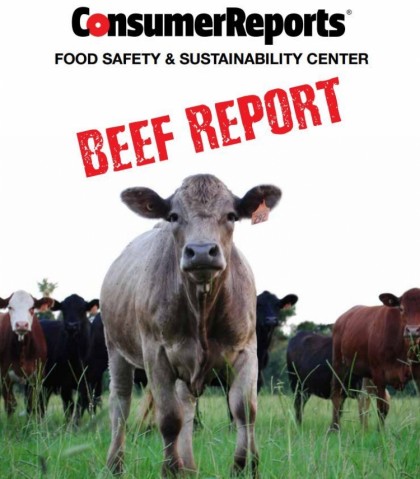DrCarney.com Blog
100% of Ground Beef Samples Contain Fecal Bacteria
"All 458 pounds of beef we examined contained bacteria that signified fecal contamination," states Consumer Reports in the September, 2015, online issue. These eye-opening results come from a study done on the United States ground beef supply. During a three-week period in October, 2014, Consumer Reports purchased 300 packages of ground beef from 26 different United States metropolitan areas; purchases were made at 103 stores including large chain supermarkets, big-box stores, and natural food stores. Ground beef from conventionally raised cattle as well as sustainably raised cattle--including some organically raised and some grass-fed--was analyzed for five common types of bacterial contaminants. The complete study conducted by Consumer Reports can be seen here.
Bacteria Contamination in Beef is Not Rare
Recalling tons of meat products due to bacterial contamination is common practice in the meat industry. From 2011 through 2014, there were more than 20 recalls of beef products in the United States. In 2013 alone, over 38 tons of meat were involved. The most recent recall occurred this year right before the Fourth of July holiday where "13.5 tons of ground beef and steak destined for restaurants and other foodservice operations were recalled on a single day because of possible contamination with a dangerous bacteria known as E. coli O157:H7." That particular type of bacterial strain is capable of damaging the intestinal lining and could possibly cause life-threatening kidney damage in some cases.
Consumer Reports decided to test ground beef because it is commonly known to carry bacteria and is reported to be a high risk for causing serious illness which requires hospitalization. Shiga toxin-Producing E. coli (STEC) is one such bacterium. "STEC produces Shiga toxin and can cause severe illness that can last five to seven days and even be so severe that infections require hospital treatment. Additionally, some people can be left with a life-threatening condition called hemolytic uremic syndrome, which damages the kidneys. STECs are also concerning because they can cause those serious infections at relatively low infectious doses," says the study.
"Between 2003 and 2012, there were almost 80 outbreaks of E. coli O157 due to tainted beef, sickening 1,144 people, putting 316 in the hospital, and killing five. Ground beef was the source of the majority of those outbreaks," says the report. It goes on to observe that for every reported case, it is suspected that there are 26 unreported incidents. Beef is also number four on the list for carrying salmonella bacteria which "causes an estimated 1.2 million illnesses and 450 deaths in the United States each year."
Survey Says . . .
From the conventionally-raised samples, 59 percent of the samples tested by Consumer Reports were positive for E. coli, 100 percent for enterococcus, 1 percent for Salmonella, and almost 20 percent contained C. perfringens, which can produce severe food poisoning, and/or blood and urinary tract infections. Eighty-two percent of samples contained two or more types of bacteria. According to the chart accompanying the Consumer Reports study, 55 percent of the samples tested positive for Staphylococcus aureus bacteria. "That toxin can't be destroyed--even with proper cooking," says the magazine. And while only 1 percent of the sample contained salmonella, the impact of only one percent can be significant "[if you] extrapolate that to the billions of pounds of ground beef we eat every year, and that's a lot of burgers with the potential to make you sick," says Consumer Reports' director of the Center for Food Safety and Sustainability, Urvashi Rangan, Ph.D. Three samples contained an antibiotic-resistant S. aureus bacteria called MRSA. Every year, this bacteria kills approximately 11,000 people in the United States. As noted by Consumer Reports, "More Staphylococcus aureus and E. coli were found on conventional samples than on more sustainably produced samples. The other types of bacteria...were distributed similarly among conventional and more sustainably produced samples." Click here for additional information on food poisoning.
Superbugs in the Beef
Today, it is routine practice for conventional cattle producers to give antibiotics to their herds. This widespread practice has led to the development of "superbugs," bacteria that are resistant to three or more classes of antibiotics. The result is that infections which were once easy to treat are now difficult to cure if not deadly. Taking this fact into account, Consumer Reports subjected all samples of ground beef to an additional round of tests "to see whether they were resistant to antibiotics in the same classes that are commonly used to treat infections in people." Of the conventional beef samples, 18 percent tested positive for superbug contamination. Perhaps even more concerning, nine percent of the sustainably produced beef and six percent of the grass-fed beef contained superbugs. According to the Consumer Reports study, "The CDC estimates that each year more than 23,000 people die as a result of an infection caused by antibiotic-resistant bacteria. Despite the importance and prevalence of that problem, the government does not have requirements related to antibiotic-resistant bacteria in any meat product." The study goes on to give the example of Salmonella. "Although the reported prevalence of Salmonella is low, the morbidity and mortality caused by foodborne illness from Salmonella is significant, and drug-resistance is particularly concerning because outbreak strains found in beef have been resistant to several important clinical antibiotics, including first-line agents prescribed to treat Salmonella and other infections." For more information on antibiotic-resistant "superbugs" see the additional links below.
Not Much Chance of Cleaning Up the Beef Supply
All meat contains hazardous bacteria that have the ability to cause serious illness, although the potential risks are higher for some types of meat. The study conducted by Consumer Reports emphasizes that "Beef, and especially ground beef, has a combination of qualities that can make it particularly problematic—and the consequences of eating tainted beef can be severe." The reason why ground beef poses greater risk is because bacteria can contaminate the meat during both slaughter and processing. There are many steps in the grinding process and because meat from many different animals can be mixed together in a single package of ground beef, there are many opportunities  for contamination to occur. The concerns of contamination in beef run high, notes Consumer Reports, because Americans tend to prefer their beef on the rare side and the contaminants don't stay on the surface of the meat. "There's no way to tell by looking at a package of meat or smelling it whether it has harmful bacteria or not," says Dr. Rangan. More than thirty million cattle were slaughtered in the United States in 2014. When bacteria are present on the surface of the meat, it gets mixed throughout the entire batch of meat, thus contaminating the entire batch. In like manner, beef and fat trimmings come from numerous carcasses, so the meat from contaminated cows can taint countless packages. Equally important, bacteria can be easily transferred throughout the entire kitchen as well onto other family members during meal preparation. Bacteria can be found not only on the cutting board and countertop, but dish towels, sponges and any utensils that were used. Hands are easily contaminated when handling the product which spreads the bacteria on the surfaces throughout the entire house.
for contamination to occur. The concerns of contamination in beef run high, notes Consumer Reports, because Americans tend to prefer their beef on the rare side and the contaminants don't stay on the surface of the meat. "There's no way to tell by looking at a package of meat or smelling it whether it has harmful bacteria or not," says Dr. Rangan. More than thirty million cattle were slaughtered in the United States in 2014. When bacteria are present on the surface of the meat, it gets mixed throughout the entire batch of meat, thus contaminating the entire batch. In like manner, beef and fat trimmings come from numerous carcasses, so the meat from contaminated cows can taint countless packages. Equally important, bacteria can be easily transferred throughout the entire kitchen as well onto other family members during meal preparation. Bacteria can be found not only on the cutting board and countertop, but dish towels, sponges and any utensils that were used. Hands are easily contaminated when handling the product which spreads the bacteria on the surfaces throughout the entire house.
Unfortunately, says Consumer Reports, the likelihood of changing industry practices to make ground beef cleaner is poor because "more than 80 percent of beef produced in the U.S. is processed by four companies. Cattle can be slaughtered at high-speed rates—as many as 400 head per hour. Those slaughterhouses use a variety of methods to destroy bacteria on the carcass after the hide has been removed, such as hot water, chlorine-based, or lactic acid washes. But when so many cattle are being processed, sanitary practices may get short shrift. The result is that bacteria from cattle hides or digestive tracts can be transferred to the meat." Consumer Reports cites Patty Lovera, assistant director of Food & Water Watch, who notes: “The economic power of the Big Four gives them a lot of political weight to push back against USDA inspectors’ efforts to enforce existing rules and to fight against any tighter safety standards being enacted.” And, she adds, “the sheer volume of beef that big-company plants crank out means that a quality control mistake at a single plant can lead to packages of contaminated beef ending up in stores and restaurants across 20 or 30 states.”
Truth for Consumers
Hearing that fecal bacteria was found in 100 percent of the samples as well as the more expensive "grass-fed" beef which also contained superbugs is disheartening for beef-loving Americans. Any type of meat product poses a risk of developing a serious illness from harmful bacteria. Switching to a life fueled by plants that avoids added oil carries no risk and makes us strong and keeps us healthy. Consumer Reports acknowledges that the "2015 scientific report of the Dietary Guidelines Advisory Committee identifies diets low in red and processed meat as healthier. It also associates diets higher in plant-based foods and lower in calories and animal-based foods with less environmental impact." In the same way, having a "plants only" kitchen will free us from worrying about cross-contamination between bacteria-carrying meat and other foods like our salads. We won't have to be concerned about making sure that the kitchen counters and cutting boards are cleaned thoroughly after meat preparation. Plants are easy that way--and safe. This brings up another old saying, "Better safe than sorry." That's a truth you can live with.
For additional information, click on the following links:
(1) What's in Your Holiday Turkey Besides Stuffing?
(2) Antibiotic Resistance = 23,000+ Yearly Deaths
(3) Antibiotics may Stop Working
(4) How To Reduce Dietary Antibiotic Intake
(5) Superbugs Invade American Supermarkets
(6) Dangerous Contaminated Chicken
Preview the "Ask the Doc!" Trailer
Your Questions Answered: In Dr. Carney's Starch-Smart® System seminars, written questions from participants are collected beforehand, protecting their privacy. In this informative video presentation, Dr. Carney shares the answer to many of those frequently asked questions - with complex scientific evidence made easy to understand. Learn the answers to what you've always wanted to ask, and so much more!
When you subscribe to the blog, we will send you an e-mail when there are new updates on the site so you wouldn't miss them.




